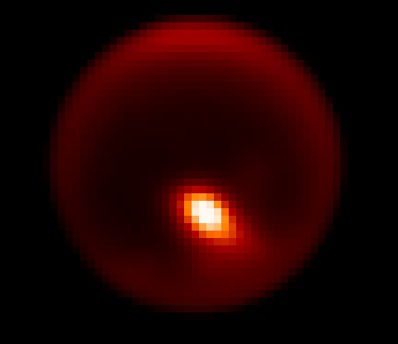



|

|

Storms in the tropics of Titan
DR EMILY BALDWIN
ASTRONOMY NOW
Posted: August 13, 2009


Ground-based observations of Saturn's giant moon Titan have revealed tantalizing evidence that its parched desert-like surface can support large-scale storm clouds that rain liquid methane.
Published today in the journal Nature, astronomers using the Gemini North telescope and the Infrared Telescope Facility (IRFT) on Hawaii announced the discovery of a cloud formation spanning three million square kilometres – equivalent to the area of India – over the moon's tropical zone near its equator.
 Gemini North adaptive optics image of Titan showing the bright storm feature. Image: Gemini Observatory/AURA/Henry Roe, Lowell Observatory/Emily Schaller, Insitute for Astronomy, University of Hawaii.
Gemini North adaptive optics image of Titan showing the bright storm feature. Image: Gemini Observatory/AURA/Henry Roe, Lowell Observatory/Emily Schaller, Insitute for Astronomy, University of Hawaii.
Leading up to the discovery cloud cover over the moon was well below one percent, and no significant clouds over the tropical regions were spotted during the previous eight years of observations. Then, over a three week period in April 2008, the cloud cover increased dramatically, first forming at a latitude of 30 degrees south then later closer to the equator.
"The first cloud was seen near the tropics and was caused by a still-mysterious process, but it behaved almost like an explosion in the atmosphere, setting off waves that traveled around the planet, triggering their own clouds," says Mike Brown of the California Institute of Technology. "Within days a huge cloud system had covered the south pole, and sporadic clouds were seen all the way up to the equator."
Although cloud formations at Titan's mid latitudes and polar regions had been observed for many years, prior to this discovery it was not known whether significant cloud formation was possible over equatorial regions.
 Gemini North infrared image of Saturn and Titan obtained using the adaptive optics system. Image: Gemini Observatory/AURA/Henry Roe, Lowell Observatory/Emily Schaller, Insitute for Astronomy, University of Hawaii.
Gemini North infrared image of Saturn and Titan obtained using the adaptive optics system. Image: Gemini Observatory/AURA/Henry Roe, Lowell Observatory/Emily Schaller, Insitute for Astronomy, University of Hawaii.
"In April 2008 we observed what was a global event that shows how storm activity in one region can trigger clouds, and probably rainfall, over arid regions, such as the tropics where Huygens landed," says team member Henry Roe from Lowell Observatory. "Of course these rain showers are not liquid water like here on Earth, but are instead made of liquid methane. Just like the streambeds and channels that are carved by liquid water on Earth, we see features on Titan that have been created by flowing liquid methane."
Small scale channels imaged by the Huygens probe that descended through the moon's thick atmosphere in January 2005 seemed to contradict atmospheric models predicting dry desert-like conditions near the equator; until now these had been explained by liquid methane possibly seeping out of the ground. Now it appears the speculation is over. "No one considered how storms in one location can trigger them in many other locations," says Brown. The same phenomenon occurs in the Earth's atmosphere.
Currently the Cassini spacecraft flies by Titan once every six weeks or so, so the continuous ground-based monitoring from the Earth plays an important role in studying features like these rapidly forming storms. But Titan's year is 30 Earth years long so there is a long way to go before fully understanding seasonal variations in the weather. "Imagine trying to understand Earth's weather having only seen what happens in January, February, and part of March," says Roe. "We have our work cut out for us to continue watching the weather on Titan for many more years."
|

|

|

|
|



